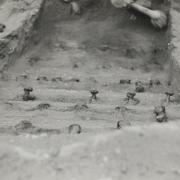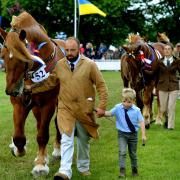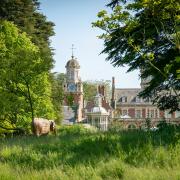Tricks, illusions, magic and other clever stuff can also deliver spectacular half-term treats. Here are a few suggestions you might enjoy
1 Game for a laugh
Southwold Pier is a glorious treat – fun, entertaining, with shops, the 80s Retro Lounge, Whacky Walk of Mirrors, novelty Water Clock and great eateries too. Enter the zany world of inventor-illusionist Tim Hunkin and the Under the Pier Show, a unique and eccentric collection of around 20 interactive alternative gaming machines. Experience through VR what it's like to be a fly, use the Zimmer frame simulator to cross a motorway, or vent your frustrations with the financial industry on the ‘Whack A Banker’ machine. Climb inside the Bathyscape, descend beneath the pier to the seabed and witness its (imagined) marvels. Try the Quick-Fit where you can get all the benefits of an exhausting workout simply by lying on a bed. There's nothing else like it – the perfect place to while away an hour or so.
North Parade, Southwold IP18 6BN Southwoldpier.co.uk

2 Do your eyes deceive you?
Look back through historical images of Bury St Edmunds and it’s a case of ‘now you don’t see it, now you do’. That magnificent 150 feet (46 metres) Millennium Tower on the cathderal may seem like it is part of the original building but it was only added in 2005. Built and rebuilt as a parish church over the centuries, it was made a cathedral in 1914, and from 1959 onwards the building was transformed into the cathedral we have today... except for the tower. Work started on the Gothic revival style tower in 2000, designed by Matthew and funded by the Millennium Commission, the Stephen Dykes Bower Trust and others. Gaze up and admire it, but go inside for the real treat, the magnificent fan-vaulted ceiling made of oak, and gilded and painted in blue, green and red.
Angel Hill, Bury Saint Edmunds IP33 1LS stedscathedral.org

3 A house in the clouds?
‘Is that a house perched high in the trees?’ you may well ask, as you arrive at the seaside village of Thorpeness. Well, sort of. It’s an illusion, a clever trick to disguise a rather ugly 50,000 gallon water tank 70ft above ground which supplied Glencairne Stuart Ogilvie’s beachside resort created in the early 20th century. The supporting steel structure provided living accommodation below the tank and was designed for Mrs Malcolm Mason, a close friend of Ogilvie’s who he later called his “lady of the stairs and starlight”. A writer of children’s books, she christened it The House in the Clouds. No longer used to supply water, it’s now a unique family holiday house with superb views from the ‘room at the top’. Treat yourself to a visit to Thorpness – enjoy the Meare, and neighbouring Aldeburgh and RSPB Minsmere. Uplands Rd, Thorpeness IP16 4NQ houseintheclouds.co.uk

4. Under the waves
Sometimes nature plays cruel tricks. The coastal village of Dunwich was once a thriving medieval port, the capital of the kingdom of East Anglia, with over 3,000 residents recorded in 1086. Then tidal storm surges in 1286 and 1287 washed away much of the harbour buildings and land. It’s Suffolk’s own Atlantis, lost beneath the waves. Research with sonar devices has enabled mapping of the underwater streets and buildings of old Dunwich. Some say that during storms you can hear the bells of lost churches ringing from under the waves. In folklore, ‘the dark heart of Dunwich’, tells of a local maiden with a broken heart who haunts the area around the beach searching for her lost love. But that’s probably a trick of the imagination. A visit to Dunwich for a walk on the beach, or to explore the ruins of Greyfriars Abbey and visit the museum is a treat. Dunwich, Saxmundham IP17 3EN dunwich.org.uk


5 Murder most foul
One of the cruellest tricks was played by William Corder, of Polstead when, in 1827, he lured his illicit lover, Maria Marten, to the Red Barn on the promise that they would elope to Ipswich where they would be married and live happily ever after. But Corder, a local farmer’s son with a reputation as a fraudster and ladies’ man, murdered Maria and buried her body under the earth floor of the barn. He fled to London to start a new life and married another woman, but for a year wrote to Maria’s family tricking them into believing that Maria was happy and well. Corder got his come-uppence when Maria’s stepmother dreamt of murder in the barn. Excavations commenced and the unfortunate Maria’s body was discovered, identifiable by her clothing. Corder was tried in Bury St Edmunds and hanged on August 11, 1828. The Red Barn no longer stands but you can enjoy a lovely walk around Polstead which takes you near the site, and visit The Cock pub where Maria’s inquest was held and Corder was detained. There’s also plenty about Corder and his trial at Moyses Hall Museum in Bury St Edmunds – always a treat to visit. Polstead Green CO6 5AL polstead.onesuffolk.net

6 Priests, pests and pirates
About 1,000 years ago a little-known order of Premonstratensian priests decided to set up home in the marshes at Minsmere. In 1182, they founded their first and only abbey in Suffolk. Plagued by floods and pestered by mosquitoes it was less than ideal. They stuck it out for 180 years, but in 1363 moved their abbey five miles inland to Leiston, dismantling it stone-by-stone. A good trick if you can do it. They left behind a small chapel, which they continued to use until dissolution in 1593. The abbot was, apparently, a tricky character. Legal documents from the time, record several allegations of piracy levelled at him for misappropriating shipping cargoes that should by rights have been landed at nearby Dunwich. Archaeologists believe there may be a navigable channel the priests were using to continue their illegal activities even after they moved inland. Minsmere chapel ruins survive. It’s a wonderful place to walk and see artist Arabella Marshall’s wonderful glass installation, A Wing and a Prayer. awingandaprayer.org.uk Minsmere Chapel, Leiston IP17 3DJ

7 The oldest trick of all?
The Anglo-Saxon king who had himself buried in a ship with his most treasured possessions may just have pulled off the greatest illusion of them all. For centuries people had been curious about the strange mounds near the banks of the Deben, just across the river from Woodbridge. Occasionally they’d have a dig around and find a few interesting things. But mostly they ignored them. It wasn’t until 1939, after Edith Pretty, who lived in Tranmer House just a few feet away, decided to properly investigate exactly what was on her land that archaeologists made a discovery that would revolutionise our understanding of early England. As they painstakingly brushed away layers of sandy soil they revealed the shape of an Anglo-Saxon ship and a burial chamber full of extraordinary treasures. The rest is history. For the full story, treat yourself to a visit to Sutton Hoo. Tranmer House, Sutton Hoo, Woodbridge IP12 3DJ nationaltrust.org.uk/sutton-hoo
READ: Murder at the mill - a walk at Easton and Letheringham

8 A wizard place to visit
The most famous wizard of modern times could have learned a trick or two from his time in Suffolk... if he’d really been here, of course. The atmospheric streets of Lavenham, lined with timber-framed buildings, proved the perfect backdrop for scenes in Godric’s Hollow in Harry Potter and the Deathly Hallows Part 1, the film version of the first part of J K Rowling’s seventh and final Harry Potter novel. Filming in Lavenham took place in secret in January 2010. Lavenham Guildhall was transformed into Harry Potter’s parents’ derelict house, while De Vere house in Water Street also makes an appearance. Lavenham will have you under its spell when you visit. Market Place, Lavenham CO10 9QZ lovelavenham.co.uk

9 A loveable rogue
The hit BBC TV series Lovejoy helped put Suffolk on the map back in the late 1980s and early 1990s. It starred Ian McShane and many different locations across Suffolk featured as the lovable rogue antique dealer and his dubious associates went about their business in a world of trickery, forgery, double-dealing, foul play and even murder. Belchamp Hall near Sudbury appeared regularly, as did Long Melford and Lavenham, Kersey, Sudbury, Bury St Edmunds and Hadleigh. It’s a beautiful part of the county to visit and stay, go walking, enjoy pretty villages with welcoming pubs, browse antiques shops... why not start at Long Melford? Park next to the Old Community Centre CO10 9DX visitlongmelford.co.uk

10 Tricks of the trade
Now here’s a chance to learn something and get a reward at the end of it. Treat yourself to a behind the scenes tour of the breweries at Adnams in Southwold or Greene King in Bury St Edmunds and pick up a few tricks of the trade. Learn how your favourite pint is brewed to perfection. At Adnams you can tour the distillery and even make your own gin. Down the road at Aldeburgh, Fishers offers tours and tastings of its hand-crafted gins at its magical distillery right next to the beach. Or over in Bury St Edmunds, drop into the speakeasy style Stillery, learn how to make your own gin and take a bottle home with you. What a treat... fishersgin.com adnams.co.uk greeneking.co.uk stillery.co.uk

11 In a tight spot
Much loved author of 101 Dalmations Dodie Smith lived happily just outside Sudbury for more than 60 years. So it’s not surprising she chose the lovely market town as the place of refuge for her canine hero Pongo and heroine Missis as they escape the clutches of the wealthy villainous trickster Cruella De Vil. "Just before midnight they came to the market town of Sudbury. Pongo paused as they crossed the bridge over the River Stour. 'Here we enter Suffolk' he said, triumphantly. They ran on through the quiet streets of old houses and into the market square...” Sudbury celebrates its literary connection by caring for a 19th century horse trough on Market Hill which is mentioned in the book, and a statue in the Talbot Trail, a self-guided tour of the town’s fascinating heritage. It's a treat of a town – birthplace of Thomas Gainsborough, with beautiful water meadows by the River Stour. Market Hill CO10 2EA sudburytowncouncil.co.uk

12 It's a kind of magic
There is nowhere quite like Orford Ness. The largest shingle spit in Europe requires a boat trip from Orford harbour to visit it. Once you’re there you’re in for a treat. It’s a wild and wonderful place – an internationally important nature reserve littered with debris and intriguing buildings from our recent military past. Here scientists worked on Radio Direction Finding (RDF) experiments, later called Radar, and top secret military testing, including nuclear weapons. The National Trust looks after the Ness and its precious wildlife. Sheep safely graze here, watched over by sheepdog Swift, who knows a trick or two. And last year, one of the county’s most loved icons, the red and white lighthouse, did a disappearing trick – dismantled and removed just before the encroaching sea could claim it. You can follow several trails that help you to explore all aspects of Orford Ness. It’s un unmissable treat. Orford Quay, Orford, Woodbridge IP12 2NU nationaltrust.org.uk/orford-ness-national-nature-reserve

13 Queen and castle
Poor Mary Tudor. She was almost tricked out of her place on the throne of England. But she had a few tricks of her own up her royal sleeve. The plot: Henry VIII died in 1553 leaving Edward VI as the only male heir. He named Mary as Edward’s successor in case his sickly son died before having children of his own. A fervent Protestant, Edward removed Catholic Mary from the line of succession, and named his cousin and fellow protestant Lady Jane Grey as heir. Mary was summoned to London to visit her dying brother during his final days. Suspecting trickery, she fled to Framlingham Castle, which she owned, and assembled her supporters who included Edward’s tax collector, Edward Mone. With the royal finances in her control and her support base growing by the day, Mary wrote to the Privy Council and eventually won their favour. On July 19 1553 Mary was proclaimed queen while she was still behind the walls of Framlingham Castle. A plaque marks the spot. Visit magnificent Framlingham Castle, get the full story and be treated to superb views from its walls 34.5 ft (10.5 metres) high. Church St, Framlingham, Woodbridge IP13 9BP english-heritage.org.uk
SUBSCRIBE: Get Suffolk magazine every month and discover more things to do



























